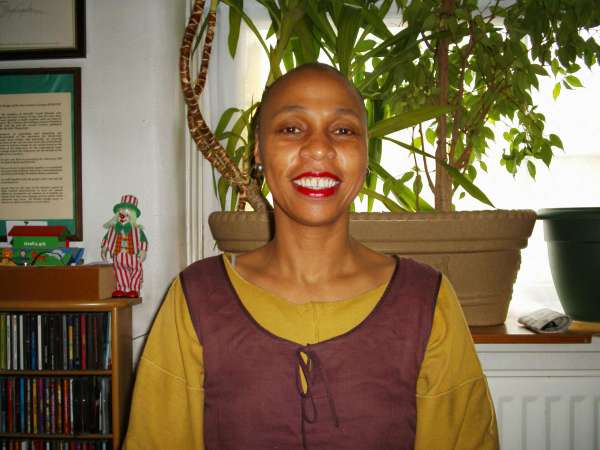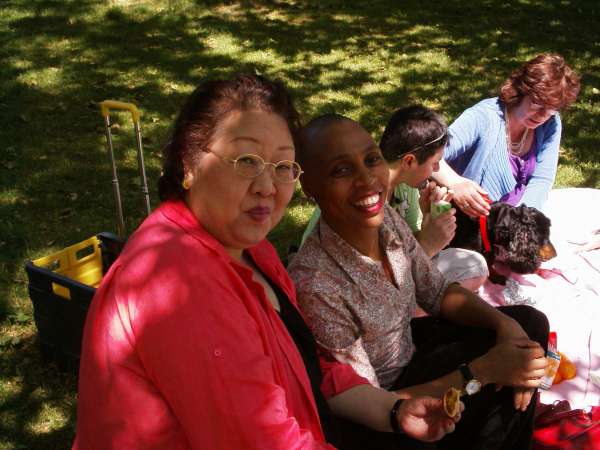
Faith is a practising Buddhist with a mission to bring fun and jollity to sick children in hospital
Last year This Way Up wrote about Dr Geehee, a Special Clown with a mission to bring fun and jollity to sick children in hospital. A therapeutic jester who slips in and out of wards and A & E waiting rooms spreading the infection of smiles. Dr Geehee is Faith Tingle, a London-based Buddhist. Here she recounts her journey of faith and where it has brought her.
I started practising Nichiren Daishonin’s Buddhism twenty-five years ago, when I was 23years old. After five busy years as a professional actress my work had suddenly dried up. This plunged me into deep depression and I embarked on a drugs-and-champagne lifestyle. Although I was very young I’d become convinced my good fortune had run out. It was during this time that I met someone at a nightclub who told me about Buddhism and chanting Nam-myo-ho-renge-kyo. I started doing the occasional bit of chanting, sometimes out loud, sometimes in my head. Although I didn’t know what the mantra meant, I liked the sound of it. But even that small amount was having a positive effect – especially on my attitude to work. I accepted a job with a children’s theatre company, something I’d previously have considered unworthy of my talents. It was the beginning of a wonderful journey that has brought me to where I am today.
While working with this company I met another Buddhist. She took me under her wing and invited me to my first meeting. I loved it. I was impressed by the openness and diversity of the participants. By the time it was over I had decided that this was my path. I was going to be an ‘out-of-the-closet’ Buddhist. From then on I attended lots of meetings and began studying too. And as my knowledge of Buddhism grew, so did my enthusiasm. I found myself naturally wanting to share this wonderful philosophy with friends and work colleagues, some of who would go on to practice.
 I was now doing the full morning and evening practice. This consists of gongyo ((the recitation of portions of the Lotus Sutra) followed by chanting. And the more chanting I did, the more courageous and hopeful I became. Over time my need for drugs and alcohol dwindled until I became totally drug-free. This was fantastic proof that my Buddhist practice really worked. The hunger state that had been so strong and destructive in my life was being transformed. It was becoming a hunger for self-improvement. A hunger to reveal this great life-state we call Buddhahood.
I was now doing the full morning and evening practice. This consists of gongyo ((the recitation of portions of the Lotus Sutra) followed by chanting. And the more chanting I did, the more courageous and hopeful I became. Over time my need for drugs and alcohol dwindled until I became totally drug-free. This was fantastic proof that my Buddhist practice really worked. The hunger state that had been so strong and destructive in my life was being transformed. It was becoming a hunger for self-improvement. A hunger to reveal this great life-state we call Buddhahood.
Right from the start I was determined to practise correctly. As a result I followed the guidance I was given by senior leaders, people sincerely practicing Buddhism for many years. On one occasion I was told the best way of creating good fortune was to say ‘yes ‘to anything I was asked to do in the organisation, thereby developing a spirit of giving and gratitude. At first I only did things when I was asked. Gradually, however, as my heart and life opened up, I began volunteering my services. I discovered the joy of making someone a cup of tea, standing on the door to welcome people to a meeting, and teaching someone to recite gongyo. I was also urged to talk to others about this Buddhism, so they too had the opportunity to overcome difficulties and make their lives shine.
Following this guidance helped bring about an inner transformation we call ‘human revolution’. And as a consequence my prayers were being answered. I was becoming happier without the help of drugs, champagne, or even a boyfriend. This doesn’t mean life was easy - it wasn’t. In fact, I was still struggling with a lot of things. Despite being an actress I suffered very low self-esteem. It took ten years and thousands of hours of chanting before I could look into a mirror and see a beautiful Buddha gazing back.
My childhood wasn’t a happy one. So when asked to help organize meetings for Mimosa - girls aged between 7 and 13 years old - I jumped at it. I wanted to be part of a group dedicated to the happiness of children. This eventually led to my appointment as Mimosa Leader for SGI-UK (see below). Six months after taking on this responsibility, however, I became very ill. I was diagnosed with Sarcoidosis, an incurable lung disease, and put on steroids. I suffered from constant breathlessness and coughing, which made it painful to chant.
This could have been a great opportunity to slow down and do less. But I wasn’t going to let my illness hold me back and determined to continue giving 100% to Buddhist activities. I set myself a monthly target of one million daimoku (nam-myo-ho-renge-kyo), as well as organising courses and supporting people by visiting them at home. I was on steroids for seven years before a new treatment for my illness was discovered. During this time I was able to transform my life on a very deep level, creating incredible good fortune in the process. One manifestation of this was meeting (name) and getting married. My illness had revealed itself as a gift. It gave me the opportunity to open my heart and develop into the best person I could be.
During my twenty-five years of practice I’ve been in over fifty theatre and TV productions. But as the 1990s drew to a close things were difficult. Acting work was thin on the ground and I was obliged to take cleaning jobs to supplement my income. At this time I was a given the guidance to the best cleaner for Kosen-Rufu (propagating the teaching of nam-myo-ho-renge-kyo). This was difficult when my great desire was to perform. Nevertheless, I took the guidance on board and worked as a cleaner for two years. I learned to do the job with joy, grateful that the money enabled me to go on Buddhist courses.
Then at the beginning of 2000 - the start of a new century and the year before I turned forty – I took the decision to give up my five cleaning jobs. I chanted abundant daimoku to discover where my work mission lay. I wanted to reveal my true potential and develop my skills. I also wanted to earn enough to live comfortably and engage fully in Buddhist activities. I chanted lots of daimoku, keeping my mind and heart open, determined to make the impossible possible and win. Within a couple of weeks I saw an advertisement in the theatrical newspaper. It was for a job with a charity that trained people to be Clown Doctors. I knew immediately that was the one for me. I applied and was accepted.
A Clown Doctor is a specially trained clown working in hospitals to bring laughter and fun to sick children. In January 2001, a month before my 40th birthday, I began my training. In May of the same year I visited Japan, birthplace of Nichiren Daishonin, the Buddha we follow, and the headquarters of our lay organization, Soka Gakkai International. While there I received guidance from the leader of the Nurse’s Group. She said to do plentiful chanting before entering a hospital so that the life state I brought into that challenging environment was high and vibrant. My attitude should be one of ‘desiring to transmit the joy of life to everyone, no matter what their circumstances’. She also asked me to determine that Clown Doctors would be established in Japan within the next seven years. When I returned in 2005 Japan was launching the Red Nose Organisation, with a team of Clown Doctors bringing laughter to the small patients of Osaka’s Children’s Hospital.
The name of my Clown Doctor is Dr Jihi. Jihi, the Japanese word for compassion, means to take away suffering and give joy. The children I visit range from the terminally ill to those being treated in the Out Patient’s Department. I clown around, perform magic, do origami, tell jokes, stories and sing songs. Sometimes I am simply a bright, friendly face in a frightening environment. Over the last eight years my work as a Clown Doctor has taken me to the Houses of Parliament and Downing Street. I work in hospitals in London, Brighton, Southampton, Sheffield, and Manchester. I am also the assistant trainer for the nine fledgling Clown Doctors who have recently joined our ranks.
I know that my work is making a real difference. My hospital visits are pure joy and laughter. During my years of practice I have learnt to give with a sincere, open heart. And because of this my life has developed dramatically. I feel gratitude for everything, both good and bad, that has happened in my life. Daisaku Ikeda, teacher, Buddhist philosopher and president of our lay organization, writes: ‘A life lived without purpose or value, the kind in which one doesn’t know the reason why one was born, is joyless and lacklustre. To just living to eat and die without any real sense of purpose surely represents a life pervaded by the world of Animality. On the other hand, to do, create or contribute something that benefits others, society and ourselves and to dedicate ourselves as long as we live to that challenge---that is a life of true satisfaction, a life of value. It is a humanistic and lofty way to live.’
‘Were you born to do this?’ the brother of a terminally patient asked me one day.
‘Yes,’ I replied. ‘I was born to do this. We’ve all been born to do something. We just have to find what it is.’
1. Soka Gakki International (SGI), meaning Society for the Creation of Value, the lay organization of our Buddhism.
